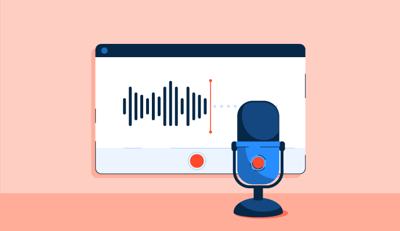December 22, 2024
 by Samudyata Bhat / December 22, 2024
by Samudyata Bhat / December 22, 2024

Written content doesn't always serve the purpose; people are switching more to voice recognition to automate routine tasks.
Whether it is transcribing documents, strengthening data privacy and building a home automation workflow, free voice recognition software allows users to take the control in their hands and simplify content generation and task management.
For different demographics, languages and accents, voice recognition software has a room for accomodation. Let's look at the top free voice recognition software which can optimize content interoperability and give you a centralized functionality.
At G2, we rank software solutions using a proprietary algorithm that considers customer satisfaction and market presence based on authentic user reviews. Our market research analysts and writers spend weeks testing solutions against multiple criteria set for a software category. We give you unbiased software evaluations - that's the G2 difference! We don’t accept payment or exchange links for product placements on our list. Please read our G2 Research Scoring Methodology for more details.
The free AI voice recognition software list below contains real user reviews from the best voice recognition software category page. It’s important to note that in the context of this list, software that requires payment after a free trial is considered free. To be included in this category, a solution must:
This data was pulled from G2 in 2024. Some reviews may have been edited for clarity.
Deepgram is an AI-powered speech-to-text platform that delivers lightning-fast, highly accurate transcriptions. Unlike traditional speech recognition, Deepgram specializes in understanding conversational language, making it ideal for transcribing calls, meetings, and other real-world audio. Its advanced features, like speaker diarization, sentiment analysis, and entity extraction, provide valuable insights beyond simple text conversion.
Pros of Deepgram |
Cons of Deepgram |
|
Accurate transcriptions, even in noisy environments or with multiple speakers |
Relies on a stable internet connection |
|
Real-time speech-to-text capabilities |
Limited language support |
|
Speaker diarization: effectively identifies and separates different speakers in audio recordings |
Lacks some advanced features like advanced sentiment analysis or speaker verification |
“I have been using their product for over two years. It is very good, and they consistently introduce improvements. We develop video and audio accessibility products, so accurate transcripts and SRT files are crucial. Their support and sales teams are highly responsive and helpful. The pricing is very competitive, and they offer excellent programs for startups. Their integration points are well-documented, and the customer dashboard is user-friendly. We can easily experiment with new options without extensive programming.”
- Deepgram Review, Jeffery P.
“One area for improvement is their logging and troubleshooting capabilities. Currently, the logging is somewhat limited, making diagnosing and resolving issues challenging. Enhancing the logging features would greatly aid in troubleshooting during issues.”
- Deepgram Review, Saran S.
Google Cloud Speech-to-Text is a powerful AI voice recognition tool that accurately converts audio into text. Using Google's advanced machine learning, it excels in handling diverse accents, background noise, and multiple speakers. With its ability to transcribe real-time audio and offer customization options, it's a versatile speech recognition solution for businesses and developers seeking reliable speech recognition.
Pros of Google Cloud Speech-to-Text |
Cons of Google Cloud Speech-to-Text |
|
Efficient real-time speech-to-text conversion |
Data privacy issues related to cloud storage |
|
Intelligent punctuation to transcribed text |
Accuracy challenges with accents, background noise, or rapid speech |
|
Easily integrates with other Google Cloud services and external applications |
Requires a stable internet connection for optimal performance |
“Google Cloud Speech-to-Text is exceptionally easy to use. It can be seamlessly integrated into any meeting or speech session. The text generation speed is nearly real-time, significantly accelerating content creation and saving users substantial time. A notable feature of Google Speech-to-Text is its automatic punctuation of sentences based on natural language processing (NLP) comprehension.”
- Google Cloud Speech-to-Text Review, Varad V.
“Along with several strengths, Google Cloud Speech-to-Text also has some limitations. Its reliance on an internet connection prevents offline use. Additionally, concerns about data privacy and Google's data handling practices exist. While generally fast, real-time transcription can sometimes experience latency issues that require improvement.”
- Google Cloud Speech-to-Text Review, Prashant G.
Krisp is an AI-powered noise-cancellation tool designed to enhance audio quality during calls and meetings. It intelligently filters out background noise like keyboard clicks, dog barks, and construction, ensuring clear communication. Unlike traditional noise cancellation, Krisp focuses on eliminating unwanted sounds while preserving voice clarity, enhancing overall call quality.
Pros of Krisp |
Cons of Krisp |
|
Effective noise cancellation |
Can experience audio quality problems like muffled voices or slight echoes |
|
Simple interface and integration |
Potential for voice distortion |
|
Wide compatibility with video conferencing platforms |
Requires an internet connection to function |
“I love its seamless integration into any video conferencing platform. It's user-friendly and offers excellent customer support. I highly recommend this software for daily workplace use.
- Krisp Review, Osbel G.
“Occasionally, the noise cancellation is inconsistent. There have been instances where it mistakenly picked up a nearby colleague's voice while I was speaking and listening to a client."
- Krisp Review, James H.
Otter.ai is an AI-powered meeting and voice recognition tool that goes beyond simple text conversion. It boasts real-time transcriptions, speaker identification, and highlights, allowing you to capture conversations and discussions as they happen. Unlike competitors, Otter.ai excels in understanding accents and integrates seamlessly with various platforms, making it a versatile solution for students, professionals, and content creators.
Pros of Otter.ai |
Cons of Otter.ai |
|
Impressive accuracy with clear audio and standard accents |
Privacy concerns regarding data storage and usage |
|
Automatically identifies and labels different speakers and recordings |
Occasional problems with automatic integration |
|
Seamless cross-platform integration |
Limited free plan |
“Otter.ai emerges as a technology with an exceptional capability to transcribe accurately. This is revolutionary for real-time meetings, calls, and audio input transcription. Its user-friendly interface and compatibility with various channels like Zoom make it highly practical. Additional team-oriented features like transcript sharing, commenting, and highlighting facilitate seamless team coordination.”
- Otter.ai Review, Eric H.
“Sometimes, due to variations in accents and speaking speed, it fails to capture everything accurately, and even if the system does manage to record some additional words, they are often incorrect. It is frustrating when the tool integrates automatically, and even when attempting to remove it from a meeting, it is difficult to eject, often sending disruptive reminder chat messages.”
- Otter.ai Review, Saniya S.
Notta is an AI-driven meeting note-taker and transcription tool that converts audio and video conversations into text, generating accurate transcripts and summaries. With features like speaker identification, search, and collaboration, Notta helps teams capture and organize meeting information efficiently, saving time and boosting productivity.
Pros of Notta |
Cons of Notta |
|
Fast and accurate transcriptions |
Features with limited user access |
|
Stand-out features like speaker identification and search |
Requires a stable internet connection for optimal performance |
|
Versatile audio and video format transcription |
Limitations on less common languages |
“What makes Notta the best for me is its speed and high-degree precision. It builds up streaming speed by audio and video from a few seconds to a couple of hours, even with many different but ridiculous dialogues or accents. I can save hours and hours of work by taking advantage of this feature over traditional transcription schemes.”
- Notta Review, Lawrence J.
“There are certainly areas for improvement. The buttons are small, and creating clips is challenging. The user interface and user experience could be enhanced significantly. Additionally, the ability to paste a Zoom or meeting link from a mobile device to join a missed call is essential. This is the core purpose of the assistant, but it's currently impractical.”
- Notta Review, Jarod T.
Hour One is a speech-to-text platform that creates, modifies and renders finished videos or audio and video files and optimizes video production ten times than the normal process. It also cuts the video production and screenwriting costs and offers a built-in dictation software for script narration and screenplay embedding.
Pros of Hour One |
Cons of Hour One |
|
High accuracy in video creation and video quality |
Limited branding capabilities |
|
Faster and more efficient customer response |
Unfriendly user interface and navigation |
|
Fast reception on client feedback and resolution delivery |
Slow load times and unclear animated voice alignment |
"Quality of video is the best out on the market! Avatar quality is not made equal, and Hour One is one if the best out there. It's pretty simple to use and the customer suport is spot on if you need help. A tool that is great if you will be using it often."
- Hour One Review, Donald P.
"There is a learning curve to making the most of the tool so not necessarily the best for the casual user."
- Hour One Review, Susan G.
Scribbl is a free to use dictation and note taking platform which transcribes the spoken words or key pointers and creates a contextual summary for the user. Scribbl formulates meeting summaries, seminar roundups, expert quotes and converts it into typed text while checking for grammar inconsistencies and spelling errors.
Pros of Scribbl |
Cons of Scribbl |
|
Innovative AI meeting assistant |
Limited credits for free meeting notes. |
|
No bot approach to note taking |
Less flexibility for note taking |
|
Intuitive interface for thought streamlining |
Not accurate transcripts generated |
What users like:
"What I like best about Scribbl is how easy and quick it is to use during meetings. The intuitive interface allows me to take notes and organize my thoughts efficiently, helping me stay focused and engaged. It streamlines the process of capturing important information, ensuring I don’t miss any key points. Overall, it significantly enhances my productivity in meetings!"
- Scribbl Review, Mercia O.
"In Portuguese, the tool still has some common errors, but I believe it is due to the low quality of the microphones. When asking something to the artificial intelligence, it would be interesting for it to show me where that answer was said."
- Scribbl Review, Guilherme M.
AssemblyAI is a powerful speech-to-text application programming interface (API) that goes beyond voice recognition. It offers advanced features like speaker diarization, sentiment analysis, and custom vocabulary, enabling deep insights from audio data. With its robust API and focus on accuracy, AssemblyAI empowers developers to build intelligent voice-enabled applications.
Pros of AssemblyAI |
Cons of AssemblyAI |
|
High accuracy in speech-to-text conversion |
Occasional latency in real-time transcription |
|
Well-documented APIs for easy integration |
Stable internet connection needed for optimal performance |
|
Speaker diarization, sentiment analysis, and custom vocabulary features |
Steeper learning curve for non-technical users |
“AssemblyAI is truly focused on product development as its core customer within organizations. Their APIs are well-defined and consistently updated. The accuracy and error rate of their speech-to-text model are industry-leading. Our customers appreciate the transcriptions and other intelligent features we can offer. AssemblyAI makes their APIs easy to use and integrate into our products.”
- AssemblyAI Review, Ryan J.
“I believe they could explore generative AI capabilities more deeply and introduce additional features beyond traditional Q&A to enhance usability and product differentiation.”
- AssemblyAI Review, Avijit C.
Express Scribe is a professional AI tool designed to simplify transcription. It offers precise playback control with keyboard shortcuts or foot pedals, enabling efficient navigation through audio files. While primarily a playback tool, Express Scribe can integrate with third-party voice recognition software, transforming it into a powerful transcription workstation.
Pros of Express Scribe |
Cons of Express Scribe |
|
Works seamlessly with foot pedals for hands-free operation |
Speeded-up audio can lose quality |
|
Several hotkeys and shortcuts to maximize efficiency |
No formatting available within the built-in word processor |
|
Easy to learn and use, with a straightforward interface |
Requires constant application updates for optimal performance |
“I appreciate how Express Scribe seamlessly integrates with the transcription foot pedal. It is a small, easily downloadable, and installable software that can be operational within minutes. There is no training is necessary for basic software functions.”
- Express Scribe Review, Sandra J.
“ I wish the editor had an auto-correct feature. This way, I don't have to transfer my work to another application for editing and proofreading.”
- Express Scribe Review, Anita S.
If you feel overwhelmed by the wealth of information about free voice recognition software, this comparison table will help you with all the important aspects:
|
Software name |
G2 rating |
Free plan |
Paid plan |
|
Deepgram |
4.6/5 |
Free plan available with $200 credit |
Starting from $4000 per year |
|
Google Cloud Speech-to-Text |
4.5/5 |
Free Usage per Month Under 60 minutes |
From $0.016 /1 minute per month |
|
Krisp |
4.7/5 |
Free plan available |
From $8/user/month |
|
Otter.ai |
4.3/5 |
Free plan available |
$8.33/user/month |
| Notta | 4.4/5 |
Free trial available |
$9/user/month |
|
Hour One |
4.5/5 | Free trial available | $25/user/month |
|
Scribbl |
4.9/5 | Free trial available | $13/user/month |
|
Assembly AI- Speech-to-Text API |
4.8/5 |
Free trial available |
Custom |
|
Express Scribe |
4.8/5 |
Free trial available | $99/user/month |
If you are interested in premium options, you can explore our guide on the best voice recognition tools in the market to get a better understand.
Most free voice-recognition software is web-based, so you only need a device with an internet connection and a web browser.
Yes, many free software offer customization options. You can often adjust voice speed, pitch, and accent to suit your preferences. Some even allow you to choose between male and female voices or different voice styles. However, the level of customization may vary between different tools.
Common output formats include MP3, WAV, and AAC.
Free versions typically come with limitations like character limits, output quality, or watermarks on the generated audio.
With a plethora of free voice recognition software options available, finding the perfect tool to bring your words to life has never been easier. By carefully considering factors like voice quality, customization options, and intended use, you can select the ideal generator to enhance your projects. Remember to explore the terms of service for each option to ensure it aligns with your commercial needs. Experimentation is key to discovering the best fit for your voiceover requirements.
We hope this list helps you find the right solution!
Dive deeper into AI voice recognition, its types, and applications across industries!
Edited by Monishka Agrawal
Samudyata Bhat is a Content Marketing Specialist at G2. With a Master's degree in digital marketing, she currently specializes her content around SaaS, hybrid cloud, network management, and IT infrastructure. She aspires to connect with present-day trends through data-driven analysis and experimentation and create effective and meaningful content. In her spare time, she can be found exploring unique cafes and trying different types of coffee.
Whenever I am driving across the city, I always resort to voice recognition-based GPS...
.png) by Shreya Mattoo
by Shreya Mattoo
Musicians, podcasters, and content creators often spare no expense for high-definition audio...
 by Sudipto Paul
by Sudipto Paul
Choosing the right AI voice assistant in 2025 isn’t just about convenience — it’s about...
.png) by Tanuja Bahirat
by Tanuja Bahirat
Whenever I am driving across the city, I always resort to voice recognition-based GPS...
.png) by Shreya Mattoo
by Shreya Mattoo
Musicians, podcasters, and content creators often spare no expense for high-definition audio...
 by Sudipto Paul
by Sudipto Paul


